Exploring Burj Khalifa's Floor Plans and Design Features
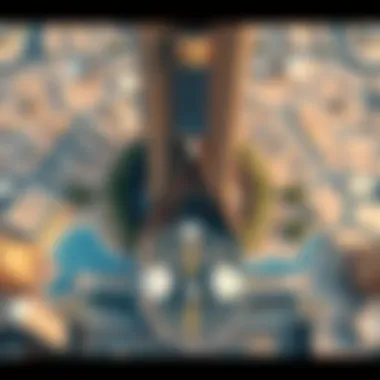
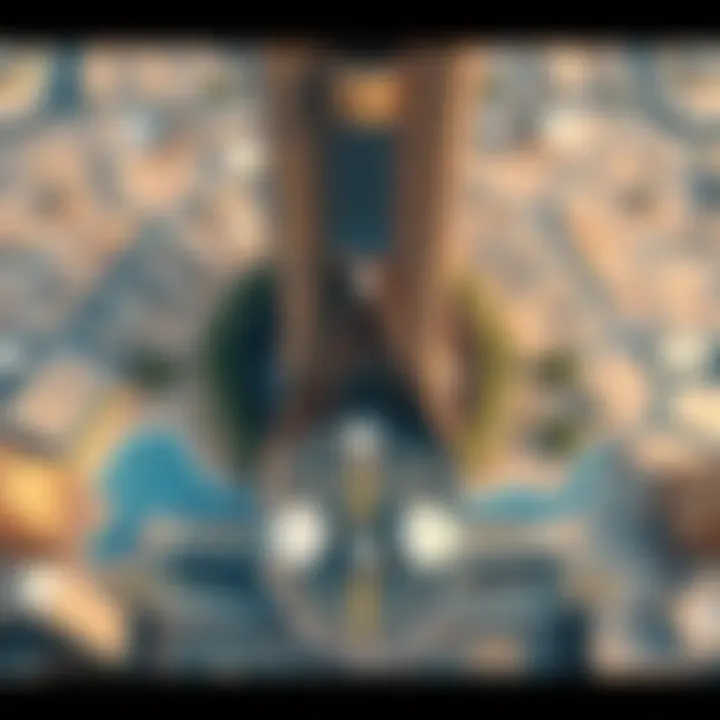
Intro
The Burj Khalifa stands as a beacon of architectural prowess, piercing the skyline of Dubai with a height that is simply staggering. As the world’s tallest building, it draws a multitude of visitors, all eager to discover what lies within its stunning facade. Not merely a symbol of luxury, this monumental structure embodies the ambition and innovation of modern engineering. A journey through its floor plans offers insights beyond mere aesthetics; it reveals the smart orchestration of space, purpose, and functionality that renders the Burj Khalifa not just a building, but an experience.
In this exploration of its floor plans, we will dissect the multiple levels that comprise this architectural marvel. Each level has unique features and uses, intended to cater to a specific demographic. From luxurious residences to high-end commercial spaces, the design intricacies help to explain why this structure continues to captivate the minds of homebuyers, investors, and even casual visitors.
The floor plans unfold stories of carefully thought-out design choices that respond both to the environment and the desires of those who inhabit them. So, let’s delve deeper and uncover the patterns and designs that make the Burj Khalifa a distinctive entity in the world of architecture.
Prolusion to Burj Khalifa
Burj Khalifa stands as a monumental achievement in architectural design and engineering. It is not just a building; it's a symbol of aspiration and innovation in the face of unprecedented challenges. The significance of this towering structure is magnified when we dive into its floor plans, which reveal the complex interplay of luxury, functionality, and cutting-edge technology. Understanding the floor plans offers insights into how space is utilized in such a vast vertical city. The planning behind Burj Khalifa is pivotal for various stakeholders including homebuyers, investors, agents, analysts, and expats. Each group can glean valuable information about living, working, or investing in this iconic skyscraper.
Historical Background
The history of Burj Khalifa is a fascinating tale marked by ambition and technological advancement. Commissioned as part of the larger Downtown Dubai development, the structure was envisioned to defy rapid urbanization in the UAE. Construction began in 2004, led by the architectural firm Skidmore, Owings & Merrill, with Adrian Smith as the lead architect. The towering skyscraper was completed in 2010, and at 828 meters, it broke multiple records, becoming the tallest building in the world. The historical context shows how regional factors, such as the discovery of oil and a growing economy, contributed to the development of such an ambitious project. This unprecedented scale reflected not only local aspirations but also a new wave of globalization in the construction industry.
Significance in Modern Architecture
In the realm of modern architecture, Burj Khalifa stands as a beacon of what is possible when design meets engineering prowess. It brought new methodologies to skyscraper construction, pushing boundaries and altering perceptions of height and sustainability. The building employs an innovative buttressed core structural system that allows it to withstand the high winds experienced at great heights. Furthermore, it integrates various state-of-the-art technologies for energy efficiency, making it a model for future skyscrapers. By showcasing the seamless blend of aesthetic value and practicality, Burj Khalifa not only enhances Dubai's skyline but also serves as a reference point for architects and engineers worldwide striving for excellence in urban design.
"Architecture should speak of its time and place, but yearn for timelessness." - Frank Gehry
In sum, the floor plans of Burj Khalifa tell a compelling story of ambition, innovation, and high-quality living that invites exploration and introspection. They highlight the meticulous planning that contributes to the building's functionality while simultaneously catering to a luxurious lifestyle. Understanding these floors will lay the groundwork for a deeper appreciation of one of the most awe-inspiring structures of our era.
Understanding the Design Philosophy
The design philosophy behind Burj Khalifa transcends mere aesthetics; it's enshrined in the core concepts of functionality, symbolism, and innovation. This section is crucial as it lays the groundwork for understanding how the architectural elements and engineering practices converge to create not just a skyscraper, but a cultural landmark. Insights into the design philosophy also help potential homebuyers, investors, and analysts appreciate the distinctive features that set Burj Khalifa apart in the realm of modern architecture.
Architectural Inspirations
Burj Khalifa’s design finds its roots in a mélange of cultural influences. The original inspiration stems from the desert flower Hymenocallis, known for its graceful appearance. This floral design is not only visually appealing but is also practical, as it minimizes wind impact on the structure. Additionally, Islamic architecture offers another layer of influence—think of the intricate patterns and grand minarets commonly seen in historical edifices throughout the Middle East.
- Cultural Reflection: The building acts as a mirror to the cultural and historical context of Dubai, blending local artistry with innovative design.
- Environmental Considerations: The design philosophy incorporates eco-friendly elements, allowing natural light to illuminate the interiors while reducing energy consumption through reflective glass surfaces.
- Adaptability: The floor plans allow flexibility to cater to both residential and commercial needs, ensuring a diverse occupancy that enriches the environment.
Innovative Engineering Solutions
Reaching unprecedented heights is no walk in the park, and it demands cutting-edge engineering solutions. Burj Khalifa is a testament to modern engineering techniques that emphasize safety, stability, and intelligence in building design.
One of the standout features is its advanced structural system, which employs a bundled tube design. This method consists of multiple tube-like structures arranged together, contributing to both strength and stability.
- Wind Resistance: By incorporating an aerodynamic shape, the building effectively minimizes wind loads. The structure sways slightly, but within safe limits, ensuring that occupants experience comfort without compromising safety.
- Foundation Engineering: The building rests on a robust foundation that undermines traditional standards. Over 192 piles were drilled into the ground, which is crucial for providing a stable base in the sandy soil of Dubai.
- Smart Technologies: The use of smart building technologies not only enhances operational efficiency but also provides a seamless experience for residents and visitors. This includes state-of-the-art elevators that ascend at lightning speeds and sophisticated security systems that ensure safety.
"The Burj Khalifa stands not only as a visual spectacle but is also a symbol of the engineering marvels that can be achieved when artistry and science work hand in hand."
This design philosophy, infused with both creative inspiration and engineered innovation, makes Burj Khalifa a unique case study. It embodies not just the aspirations of Dubai but also sets benchmarks in architectural and engineering endeavors worldwide.
Overview of the Floor Plans
Understanding the floor plans of Burj Khalifa is key to appreciating its architectural significance and functionality. This towering edifice is not just a testament to human ingenuity; it represents a masterclass in space utilization, combining various uses within its soaring heights. Each floor is meticulously designed to cater to different needs, from residential to commercial, thus making the structure a bustling hub of activities.
The importance of examining the floor plans lies in recognizing how each component interacts to create a cohesive living and working environment. The way the spaces are crafted brings to light considerations such as privacy in residential units, openness in office layouts, and amenity access throughout the building. This intricate balance enhances the user experience, providing both luxury and incentive for business or residence.
Moreover, having an overview of the floor plans helps potential homebuyers, investors, and even expats gain insight into what residing or operating within such a prestigious structure entails. It showcases aspects like natural lighting, spatial organization, and access to communal areas, revealing why this skyscraper is more than just a marvel of height—it's a well-orchestrated urban ecosystem.
“Architecture should speak of its time and place, but yearn for timelessness.”
—Frank Gehry
Residential Levels
Burj Khalifa's residential levels represent the epitome of high-end living, featuring 900 private residences that range from one to four-bedroom apartments. Each unit is a sanctuary meticulously crafted with modern amenities and opulence in mind. The layout emphasizes a blend of comfort and luxury, with wide living spaces bathed in natural light, thanks to expansive floor-to-ceiling windows that offer breathtaking views of Dubai below.
Among the alluring features, residents may find:
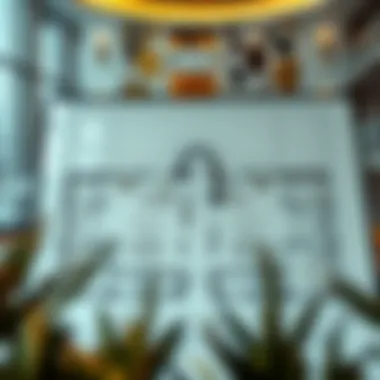
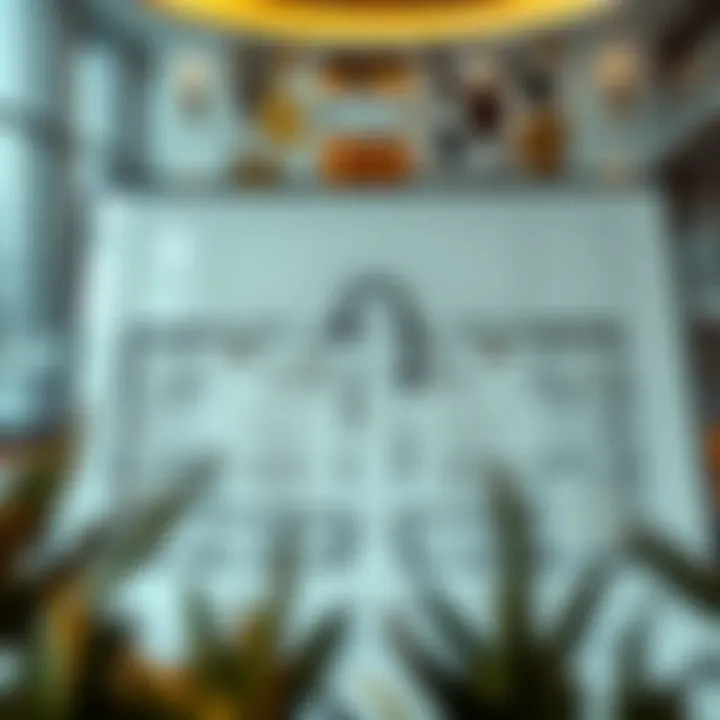
- Personalized interiors, allowing for creativity in design choices.
- State-of-the-art appliances to cater to contemporary lifestyles.
- Dedicated concierge services, which enrich the experience of living in such a prominent location.
This thoughtful planning emphasizes leisure with spaces designed for relaxation, alongside facilities such as a gym, spa, and various pools within the building. For residents, these levels provide not just a home but a lifestyle—one that speaks to luxury and convenience, often drawing comparisons to exclusive living complexes in cities around the world.
Commercial Spaces
Commercial spaces within Burj Khalifa are as sophisticated as the residential areas, hosting offices that cater to multinational corporations and local businesses alike. These spaces are strategically designed for practicality and efficiency, boasting open-floor layouts that stimulate productivity and collaboration. Businesses benefit from unparalleled views that can inspire creativity and foster an innovative work atmosphere.
In addition to standard office designs, the commercial section hosts:
- Flexible office suites suitable for startups and established firms.
- Meeting and conference rooms equipped with cutting-edge technology.
- Networking areas where professionals can connect informally, enhancing the building's sense of community.
This blend of practicality and luxury in the commercial floor plans makes it an attractive site for various enterprises looking to make a statement in one of the world's most recognizable buildings, thus contributing not just to commercial success but to Dubai’s economy as a whole.
Observation Decks
Burj Khalifa is notable for its observation decks, which serve dual purposes—offering stunning 360-degree views while also functioning as key tourist attractions. The decks are situated on the 124th and 148th floors, each designed to provide a unique perspective of the surrounding landscape.
Visitors can expect:
- Sleek viewing platforms ensuring unobstructed sightlines of Dubai’s skyline.
- Interactive displays that educate tourists about the city and the tower’s construction.
- Exclusive lounge areas, allowing guests to enjoy beverages while soaking in the panoramic vistas.
These observation decks not only cater to tourism but also act as symbolic gateways to experiencing the height of modern architectural achievement. They are destinations in their own right, enticing millions to visit and marvel at the engineering wonder that is Burj Khalifa, and offering unforgettable experiences that resonate long after people leave.
Navigating through the floor plans of this skyscraper sheds light on how architectural design can elevate function and aesthetic, making Burj Khalifa not just a building, but an experience in itself.
Floors of Burj Khalifa: A Detailed Breakdown
The floors of Burj Khalifa deserve special attention within the broader context of its architectural narrative. The breakdown of each level presents insights into not only the functional aspects of the skyscraper but also the design elements that elevate it beyond mere height. Each floor serves a distinct purpose, contributing to the overall harmony of the structure.
Understanding these levels is essential for potential buyers, investors, and enthusiasts who seek to appreciate what lies within this remarkable edifice. The unique feature of Burj Khalifa is its mixed-use functionality; it hosts residential areas, corporate offices, and leisure facilities, all skillfully interwoven.
Ground and Lower Levels
The ground floor is the initial point of interaction with Burj Khalifa, providing access to the masses that marvel at its stature. It is not just a foundation; this level has an elegant foyer that sets the tone for the entire building. Visitors step into an expansive lobby adorned with intricate Arabic calligraphy, showcasing the blend of modern and traditional aesthetics. This area also features the ticketing for the observation deck, offering a glimpse of the bustling activity that characterizes this iconic location.
Below the ground floor, the lower levels are designed to accommodate the building’s infrastructure. This includes utility and service areas that are vital for the building’s operations. Here’s how the ground and lower levels contribute:
- Security and Access Control: High-tech systems ensure safety for residents and visitors.
- Service Entrances: Dedicated entry points for maintenance and operational services, keeping disruptions to a minimum.
- Parking Solutions: Ample parking space for residents and guests.
Mid-Level Features
Ascending through the array of floors, the mid-levels play host to various corporate environments. With their panoramic views of Dubai, these floors cater primarily to businesses seeking sophisticated office space coupled with a professional atmosphere. The layout incorporates spacious offices, collaborative zones, and lounge areas, enhancing productivity and creativity.
Additionally, the mid-level features are equipped with cutting-edge technology, ensuring that the workspace remains at the forefront of modern design. The thoughtful arrangement of light and space creates an inviting ambiance. Consider these key aspects:
- Flexible Office Spaces: Designed to cater to various business needs, from small startups to large corporations.
- Communication Infrastructure: Advanced systems support connectivity, crucial in today’s business environment.
- Sustainability Measures: Elements like energy-efficient lighting and climate control contribute to a reduced environmental footprint.
Upper Levels and Skyscraper Functionality
As we reach the upper levels, a different narrative unfolds. These floors blend luxury living with breathtaking views of the landscape below. The residential areas, crafted with meticulous attention to detail, resonate with opulence. Each apartment boasts expansive windows that frame the stunning vistas of Dubai and beyond.
The functionality of these upper levels is remarkable. They are not just spaces to live; they are communities. With amenities that rival some of the world's finest hotels, residents have access to fitness centers, swimming pools, and private lounges. Important aspects include:
- Elevated Amenities: Exclusive access to recreational areas designed for relaxation and leisure.
- Community-forward Planning: Social spaces that promote interactions among residents, encouraging a vibrant community atmosphere.
- Architectural Grandeur: The design aesthetics reach their zenith, with materials and finishes that speak to luxury and refinement.
The Burj Khalifa isn’t merely about reaching for the sky; it’s a testament to urban living in the 21st century, where every inch is meticulously planned.
Overall, the detailed breakdown of the floors within Burj Khalifa reveals a multilayered approach to urban design, merging functionality with aesthetics in a way that continues to inspire.
For further insights into the structural elements of Burj Khalifa, visit Wikipedia or explore architectural discussions on Reddit.
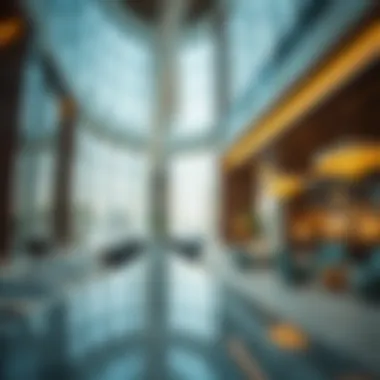
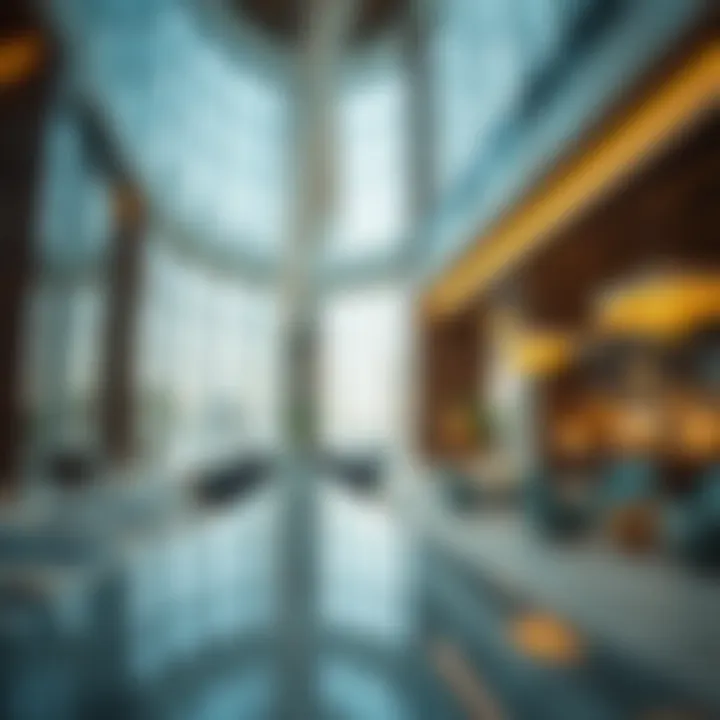
Residential Units: Luxury and Design
When dissecting the Burj Khalifa, one cannot overlook the residential units that occupy a significant part of this architectural marvel. The design and luxury of these spaces play a crucial role in illustrating the building's identity. Not only do they reflect a high standard of living, but they also shed light on the innovative approaches to modern urban living. The array of residential units showcases not merely opulence but a unique blend of comfort, functionality, and aesthetic appeal.
Types of Residential Units
The Burj Khalifa houses 900 private residences, offering a variety that caters to different preferences and lifestyles. The types of units range from one to three-bedroom apartments, penthouses, and even full-floor residences. Each of these types provides a unique experience, ensuring that residents can choose the one that best fits their needs.
- One-Bedroom Apartments: Ideal for singles or couples, these units are designed for efficient use of space without compromising luxury. Features include high-end appliances, spacious living areas and breathtaking views.
- Two-Bedroom Apartments: Suitable for small families or those needing extra space, these apartments offer more functionality, often featuring an additional bathroom and larger communal areas.
- Three-Bedroom Apartments: These are aimed at larger families, boasting multiple bedrooms and expansive living rooms, along with enhanced facilities to ensure comfort.
- Penthouses: The crown jewels of Burj Khalifa’s residential offerings, the penthouses provide unparalleled luxury. With private terraces, generous living spaces, and exclusive amenities, they embody the pinnacle of high-end living.
The selection of residential units caters to a wide audience, ensuring inclusivity within the luxury segment of Dubai's real estate market. By providing options that suit varying living requirements while maintaining premium quality, Burj Khalifa reinforces its status as a global icon.
Interior Layout Considerations
Designing the interior layouts of residential units in the Burj Khalifa was not just about aesthetics; it was about thoughtful planning that enhances the lifestyle of residents. Key considerations included:
- Open-Plan Living: Many units feature open layouts that allow natural light to flow throughout the space, creating an airy and spacious atmosphere. This design choice helps in maximizing the scenic views of the Dubai skyline.
- Luxurious Materials: The interiors utilize high-end finishes, such as marble flooring and custom cabinetry, which contribute to a sophisticated ambiance. The choice of materials not only enhances visual appeal but also underlines the quality of craftsmanship.
- Smart Home Technology: Each unit comes equipped with state-of-the-art technology to manage lighting, temperature, and security, tailoring the living experience to modern needs.
- Maximizing Views: Because of the unique height and positioning of the Burj Khalifa, designers made sure that each residential unit capitalizes on stunning panoramic views, often with floor-to-ceiling windows that invite the outside in.
"Living at Burj Khalifa is not merely about residing in a building; it is about experiencing a lifestyle that embodies elegance and innovation."
For more information on this skyscraper’s design and influence, consider visiting resources such as Wikipedia and Britannica.
The exploration of luxurious residential units within this historic building is a promising topic for buyers, investors, and those simply curious about luxury living at its finest.
Commercial Spaces Within Burj Khalifa
The Burj Khalifa stands not only as a remarkable architectural feat but also as a hub for commercial activities that significantly contribute to the economy of Dubai. The incorporation of commercial spaces within this iconic skyscraper is vital for both the functionality of the building and the vibrancy of the surrounding area. These spaces do more than provide business opportunities; they create a dynamic ability for various enterprises to thrive in an environment designed to reflect luxury and innovation.
Offices and Their Layout
The office spaces in Burj Khalifa are strategically situated on levels 111 to 121. This design choice is not arbitrary; it allows businesses to enjoy stunning views while conducting their operations. The flexible floor plans cater to a range of business needs, from small startups looking for a prestigious address to larger corporations requiring spacious layouts.
Key elements of the office layouts include:
- Adaptive Spaces: Configurations can be adjusted based on tenant needs, promoting ease for both individual and collaborative work.
- Natural Light: Floor-to-ceiling windows not only enhance the aesthetics but also promote a healthy work environment.
- Prestigious Amenities: Businesses benefit from proximity to upscale dining options and bustling retail outlets, which can be essential for both client meetings and employee satisfaction.
This integration of offices within the Burj Khalifa presents an attractive prospect for companies poised to make a statement in the commercial world.
Retail Spaces Analysis
The retail spaces on the ground level and inside the Dubai Mall extension offer more than just shopping; they provide an immersive experience to visitors and residents alike. Burj Khalifa's retail strategy targets high-end brands, creating an allure that complements the luxurious atmosphere of the building.
Characteristics of the retail landscape include:
- Diverse Offerings: From high fashion to gourmet cuisine, the range of retailers mirrors the diverse populace of Dubai itself.
- Strategic Location: The shopping experience is designed to allow for seamless transitions between office, residential, and leisure environments, enhancing foot traffic.
- Architectural Integration: The aesthetic harmony between the building’s architecture and the retail experience creates an inviting atmosphere for consumers, making them feel part of something grander.
This feeder mix between commercial offices and retail on the ground level not only supports businesses but also strengthens the economic fabric of the region, demonstrating how carefully curated commercial spaces can enhance the value of an iconic property like the Burj Khalifa.
"The integration of commercial spaces within the Burj Khalifa is a prime example of urban planning that reflects both ambition and utility, setting a precedent for future developments."
Commercial spaces within the Burj Khalifa indeed play a crucial role in shaping the identity and functionality of this monumental structure. Investors and businesses looking to position themselves in the bustling heart of Dubai would find the opportunities here hard to resist.
For further information on Burj Khalifa's commercial space, visit Wikipedia or Britannica.
Infrastructure and Amenities
When delving into the floor plans of Burj Khalifa, the significance of infrastructure and amenities cannot be overstated. They are crucial in not only providing comfort and convenience to residents and visitors but also enhancing the overall functionality of the building. In a structure that reaches heights of over 828 meters, the design and execution of these elements are paramount.
Elevator Systems
One of the standout features of Burj Khalifa is its remarkable elevator systems, which serve as the lifelines of this towering giant. With a total of 57 elevators, the efficiency of movement within the building is a pivotal consideration due to the sheer number of floors. Each elevator is engineered to travel at speeds of up to 10 meters per second, ensuring that access to the varying levels is both swift and smooth.
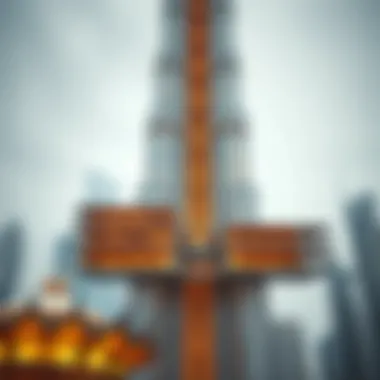
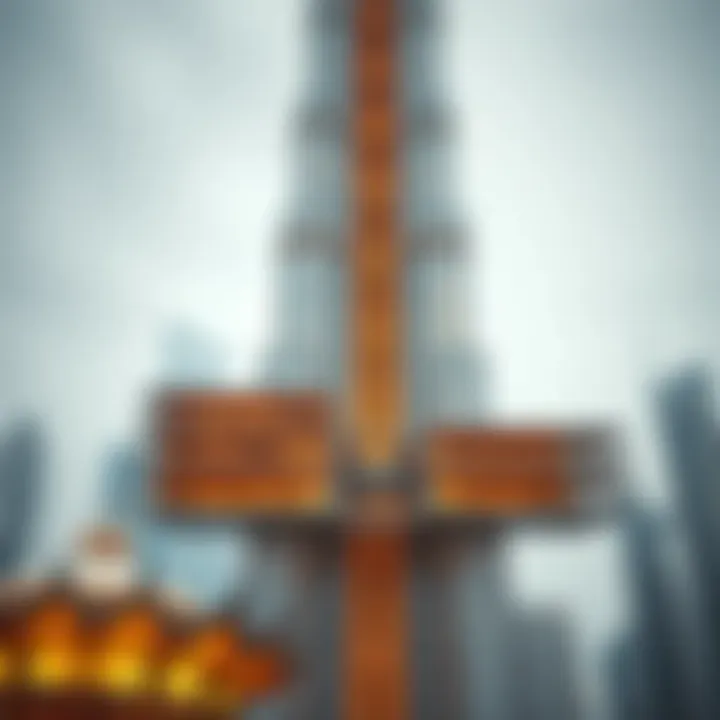
Moreover, the high-capacity elevators feature a double-decker design, maximizing the number of occupants they can transport at once. This is especially beneficial during peak hours when foot traffic surges. The elevators are equipped with advanced safety features, including systems that allow them to function even during electrical outages. This is not only about convenience but also about ensuring safety and reliability for all users.
"In a building where time is of the essence, the elevator systems go beyond mere functionality; they enhance the living experience and operational efficiency."
Recreational Areas
Another vital aspect of the Burj Khalifa's infrastructure is its thoughtfully planned recreational areas. Spanning several floors, these zones offer respite and leisure amidst the hustle and bustle of city life. From gardens to observation decks, the amenities are designed to cater to various lifestyles.
For instance, the landscaped gardens on the 7th floor provide a serene escape for residents and workers alike. They are designed not just for aesthetics, but also to promote relaxation and social interaction. These spaces often host community events and gatherings, fostering a sense of belonging and enhancing communal ties.
Additionally, the observation decks at the 124th and 148th floors offer breathtaking views of the Dubai skyline and beyond. Equipped with state-of-the-art facilities, these areas ensure that visitors and residents can enjoy their surroundings comfortably. Whether it is a casual visit or a formal event, the recreational zones of Burj Khalifa serve as versatile spaces for myriad activities.
These infrastructure components combined create a multidimensional experience within Burj Khalifa. From the practicality of the elevator systems to the inviting recreational areas, every detail contributes to the building’s position as a landmark not just in Dubai, but in the world of modern architecture.
Impact on Dubai's Skyline
The Burj Khalifa stands as not just a building but as an icon that has fundamentally transformed the skyline of Dubai. This740-meter-tall skyscraper is often regarded as the bold statement of a city that refuses to be less than extraordinary. The design, more than merely a structure, serves as a testament to modern ingenuity, drawing both architectural enthusiasts and investment interest from around the globe.
Significance of the Burj Khalifa: The Burj Khalifa’s impact on Dubai extends beyond its height. It has become a key landmark known for its unique design and engineering feats. The tower’s shape mimics the Hymenocallis flower, symbolizing the connection between nature and architecture, which paints a captivating picture against the vibrant skyline. Such a striking landmark beckons tourists who contribute substantially to the local economy.
With the Burj Khalifa,
- Dubai has set a benchmark. The height alone challenges other cities to rethink their architectural possibilities, bringing forth a competitive spirit in mega-cities worldwide.
- A catalyst for growth. The building has led to significant urban development in its vicinity. The surrounding area is dotted with luxury hotels, shopping malls, and office spaces, thanks to the attraction the Burj Khalifa generates.
- Symbol of national pride. For many Emiratis, the Burj Khalifa represents the fruition of their aspirations. Its silhouette against the sunset is so iconic that it has become intertwined with the identity of Dubai.
"The Burj Khalifa is not merely a high-rise; it is a symbol of human ambition and the capacities of modern engineering."
Symbol of Modern Dubai
The Burj Khalifa has become synonymous with modern Dubai and stands tall as a beacon of what the city represents today. It embodies innovation, opulence, and vision that exemplifies the lifestyle aspirations of UAE residents. This transcendent structure houses luxurious apartments, offices, and hotels, making it a hub of activity that continuously attracts both locals and tourists.
- Architectural prowess: Characterized by its sleek lines and shining façade, the Burj Khalifa showcases what is possible when design meets functionality. The structure itself pushes the envelope on architectural limits, forcing the world to take a closer look at Dubai as a center of excellence in skyscraper design.
- Cultural significance: It serves as a backdrop for various cultural festivities, including the awe-inspiring New Year’s Eve fireworks shows. This famous landmark creates not just a visual aesthetic but fosters community spirit and unity, inviting people from all corners of the globe to celebrate together.
The Burj Khalifa represents a pivotal moment in Dubai’s history, marking its emergence as a key global player on the economic stage.
Burj Khalifa and Urban Development
The influence of the Burj Khalifa on urban development in Dubai showcases the dynamic interplay between architecture and urban planning. Its presence has prompted not simply an aesthetic transition in the landscape, but a comprehensive rethinking of urban spaces and their utilization.
- Repositioning of infrastructure: The skyscraper has triggered significant investments in public transport and infrastructure in surrounding areas. The integration of pedestrian walkways, parking facilities, and public transport terminals serves to improve accessibility while encouraging a vibrant urban atmosphere.
- Catalyst for real estate: The Burj Khalifa has also spurred a flourishing real estate market, where properties in close proximity to the skyscraper have shown a remarkable uptick in value. This demand reflects the broader trend of urban consolidation and investment in central, high-value locations.
- Green spaces and amenities: As the city has expanded, the introduction of parks and recreational areas means that despite the density, the overall environment remains livable and enjoyable for residents and visitors alike.
The skyscraper is at the forefront of urban development in Dubai, proving that luxurious living can coexist with the demands of a modern metropolis.
Future Developments and Perspectives
The Burj Khalifa stands as a hallmark of architectural innovation, but the journey doesn't stop at its completion. Exploring future developments and perspectives of this iconic skyscraper unveils a tapestry of possibilities that can reshape not just the building itself but also the entire Dubai skyline. Such future developments hinge on various elements, spanning market trends, maintenance of the property, and potential renovations that could further enhance its stature.
Expectations for Burj Khalifa
The expectations for Burj Khalifa are as towering as its physical form. Architects and city planners often speculate on the way this landmark might evolve in the forthcoming decades. Anticipated enhancements could include:
- Smart Technology Integration: As cities transition into smarter ecosystems, the Burj Khalifa may adopt cutting-edge tech, from energy-efficient systems to automated amenities.
- Sustainable Practices: With a stronger push toward sustainability, possibilities like green roofs or solar panels to decrease energy consumption may loom on the horizon.
- Cultural and Recreational Spaces: Future renovations may involve the establishment of new cultural hubs, like galleries or exhibition spaces, promoting art and local culture within the building’s vast framework.
It's essential to keep an eye not only on the physical structure but also on how people's needs and lifestyles change over time.
Such expectations signal not just a growing adaptation to new technologies and societal standards, but also an effort to maintain the relevance of the Burj Khalifa in an ever-evolving urban landscape.
Broader Impact on Real Estate Trends
The impact of Burj Khalifa on real estate trends goes deeper than just its immediate surroundings. Its presence has catalyzed remarkable shifts in the regional property market.
Among the broader implications include:
- Increased Property Values: Surrounding neighborhoods have witnessed surges in property values, thanks to the prestige associated with living near or within the Burj Khalifa.
- Attracting Investors: As the tallest building globally, it continues to lure in both local and international investors, who see substantial value in property linked with such an iconic fixture.
- Urban Development: The Burj Khalifa has set a benchmark for modern skyscrapers and urbanization in Dubai, prompting architecture firms and developers to think bigger and bolder, causing a ripple effect in the market.
The building thus serves as a barometer for future real estate trends, echoing the aspirations and ambitions of urbanity. This feedback loop not only influences investment strategies but also promotes innovative housing solutions.
In summary, the Burj Khalifa is not a static monument; it is an evolving entity. The future developments tied to it will undoubtedly shape not only its own identity but also the broader dynamics of Dubai's real estate and urban landscape.







